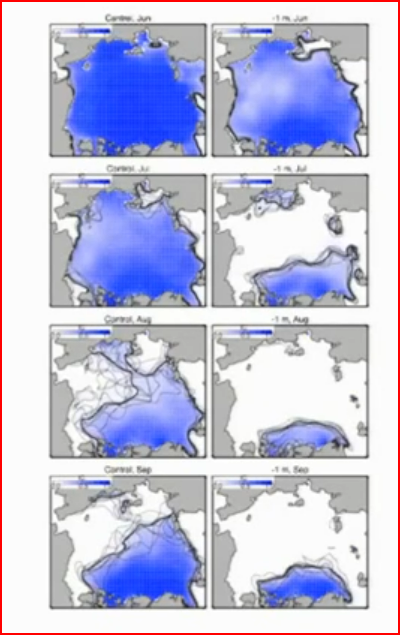Sea Ice Sailor,
The melt front is very important, as is the estabishment of melt front. But in PIOMAS most of the volume loss comes from thinning away from the ice edge, not the retreat of the melt front (by virtue of the greater surface area away from the ice edge). The issue then becomes how quickly open water can be produced.
I don't know if you are aware of the PIOMAS -1m experiment.

This was organised by Ed Blanchard Wrigglesworth for a SIPN webinar last year (or the year before?). In the first column are Jun/Jul/Aug/Sept PIOMAS average for recent years. In the second column is the progression with June starting as in recent years on the last day of May but with ice thinned across the pack by 1m from the first day of June.
What is striking is the fast retreat through June, such that the July average is so low. I could email Dr Zhang about this... I suspect that rather than a severely fragmented pack going rotten from the inside with large tracts of open water what would happen is a staggeringly fast recession of the ice edge.
Obviously the initial stage of loss associated with June thining would cause concentration to plummet as open water develops between floes. But my reasoning regards a rapid retreat of the ice edge is as follows:
Within the pack, with melting ice in close proximity, while open water between floes will lead to enhanced ice/ocean albedo feedback, the presence of melting ice will keep temperatures close to zero. As heat flux is proportional to temperature difference this will limit the flux of heat from ocean to ice.
Contrast this with the situation at the ice edge. Here, once a body of water has opened away from the ice, the only limit on ocean warming is deep conduction/mixing of heat with deeper sub surface waters (the latter from wind/wave action), and (mainly) evaporation to the air losing heat (also LW emission). So temperatures can climb well above freezing and the potential for heat conduction into ice at the ice edge is substantially increased. This means that the ice edge is subjected to a greater heat flux than dispersed floes behind the ice edge, hence it retreats fast.
These considerations would go some way towards explaining why the ice melts from an edge rather than just going patchy.
